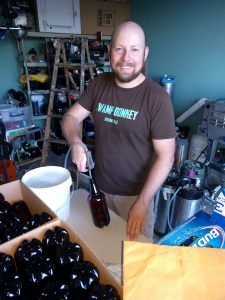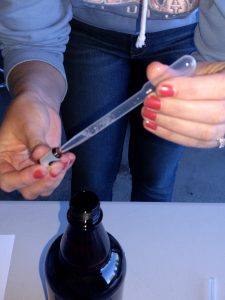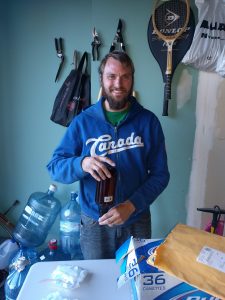This past Friday, we held our first Prairie Dog event: Off-Flavour Tasting. As you may or may not know, it is possible for beer to have “off-flavours”, due to some incorrect process in the production, or due to contamination. Many of these flavours are known, and it is possible to tell what went wrong based on the off-flavour present.
We bought a kit that includes several off-flavours as well as typical “on-flavours”. For this event, we focused on off-flavours, and chose eight common off-flavours to use this first time. The idea was to add these flavours to beer, and to ask people to guess which were tainted.
We decided to have eight rounds of tasting. In each round, each participant would get three cups of beer. One cup would be tainted. Everyone would have to guess which of the three cups had the off-flavour. At the end of the round, the answer, including what the off-flavour was, would be revealed, and we’d talk about what that flavour smells and tastes like to different people, and what in production can cause that flavour.
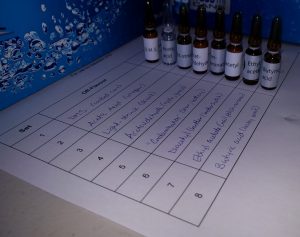 Logistically, we had to figure out how to do this so that only one person knew which beers were tainted, and how to do it so that the evening flowed without everyone having to wait too long between rounds. We also only had one vial of each off-flavour, so we had to design this procedure carefully.
Logistically, we had to figure out how to do this so that only one person knew which beers were tainted, and how to do it so that the evening flowed without everyone having to wait too long between rounds. We also only had one vial of each off-flavour, so we had to design this procedure carefully.
First of all, we chose to add our off-flavours to a commercial light lager, one which did not have a strong aroma or flavour of its own to mask the flavours we were going to add. According to our flavour kit, each vial contained enough liquid to be detected in one litre of beer. In order to keep this a blind test, we decided that for each round of tasting, we would have three one-litre bottles of beer, where one was tainted. Each participant would receive a shot from each bottle for their tasting. We used plastic, amber bottles: amber to protect the beer from UV, and plastic for its ability to be reused by us. Using bottles for the ‘pristine’ beer as well and the tainted beer would enable us to: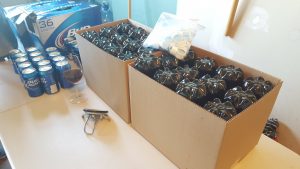
1- Hide the identity of the tainted beer from everyone, including the pourer;
2- Keep track more easily of what to pour in each round;
3- Allow all the beer to have the same amount of carbonation.
Since we were preparing the beer the day before, it was important to us that the loss of carbonation occurred to the same degree for every pour. Ideally, we wanted to buy a keg of beer and fill our one-litre bottles from there. However, we needed 24 litres of beer (8 rounds x 3 litres), and the kegs available were either too small or too large – and we didn’t want to have a lot of wasted beer. So, what did we do? Laura went out and bought 72 cans (two 36-packs) of beer.
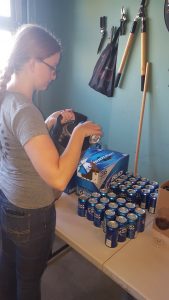 The one-litre bottles were not marked for volume, so we filled a one-litre measuring cup with water, and poured it into one of the bottles. One litre was approximately halfway up the neck of the bottle – close enough for our purposes, since this is not a quantitative experiment. So we knew how much to fill each bottle. But how to fill them from 355-millilitre cans? First we tried just pouring the cans straight into the bottles, with and without a funnel. Either way, we got a lot of foam in the bottle, and so we decided it would take way too long to fill all the bottles, having to wait for the foam to die down each time we poured. Plus, we would lose a lot of carbonation. In the end, we decided to use a keg.
The one-litre bottles were not marked for volume, so we filled a one-litre measuring cup with water, and poured it into one of the bottles. One litre was approximately halfway up the neck of the bottle – close enough for our purposes, since this is not a quantitative experiment. So we knew how much to fill each bottle. But how to fill them from 355-millilitre cans? First we tried just pouring the cans straight into the bottles, with and without a funnel. Either way, we got a lot of foam in the bottle, and so we decided it would take way too long to fill all the bottles, having to wait for the foam to die down each time we poured. Plus, we would lose a lot of carbonation. In the end, we decided to use a keg.
While everyone else was busy doing other Prairie Dog-related things, I had the fun task of filling two of our kegs with 72 cans of beer (I got help opening the cans near the end 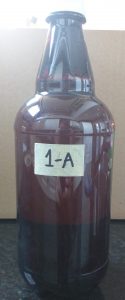 because my fingers hurt!). Luckily, the kegs had already been cleaned and sanitized. I tried as much as possible to reduce the foam by pouring down the inner sides of the kegs, but still, there was a lot of foam. Technically we only needed 68 cans (24 L/355 mL = 67.6), but we used them all to compensate for the foam. Once all the cans were emptied into the kegs, Gerad and Tyler filled the kegs with carbon dioxide. We probably lost less carbonation doing this than if we had filled the bottles directly from the cans.
because my fingers hurt!). Luckily, the kegs had already been cleaned and sanitized. I tried as much as possible to reduce the foam by pouring down the inner sides of the kegs, but still, there was a lot of foam. Technically we only needed 68 cans (24 L/355 mL = 67.6), but we used them all to compensate for the foam. Once all the cans were emptied into the kegs, Gerad and Tyler filled the kegs with carbon dioxide. We probably lost less carbonation doing this than if we had filled the bottles directly from the cans.
Every bottle was labeled with a number and a letter, in the form of #-A, #-B, and #-C, where # is the round, and A, B and C correspond to the participants’ cups. For every round, I chose either A, B or C to contain the off-flavour. I used the Tracking Sheet to randomly assign each off-flavour to a round, and within that round, which bottle would contain that off-flavour.
We filled the bottles as an assembly line: Gerad filled a bottle from the keg, I took it behind a wall of boxes (so that the Tracking Sheet was hidden from the others) and either did or did not add an off-flavour, according to the Tracking Sheet, and Tyler screwed on the cap then inverted the bottle a few times to mix the beer with the off-flavour. The off-flavours came in liquid form in glass vials. The type of vials they were in are called ‘ampoules’. Ampoules are fully sealed, and to open them you actually break the top off, with it breaking along a line etched in the glass.

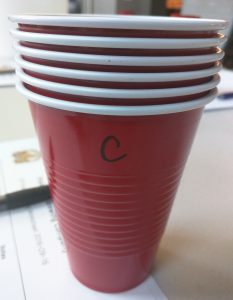 The final materials preparation we did was to label cups. We were planning on up to 15 participants, so each participant was to receive two-ounce pours per tasting using a standard shot glass (1 L/15 = 67 mL = 2.3 oz). We sorted the cups into two sets of three cups per person, and labeled each set A, B, C. The idea was to be pouring the next round into the participants’ spare sets of cups while they were still tasting in the current round.
The final materials preparation we did was to label cups. We were planning on up to 15 participants, so each participant was to receive two-ounce pours per tasting using a standard shot glass (1 L/15 = 67 mL = 2.3 oz). We sorted the cups into two sets of three cups per person, and labeled each set A, B, C. The idea was to be pouring the next round into the participants’ spare sets of cups while they were still tasting in the current round.
The bottles of beer were refrigerated overnight and until the event the following day!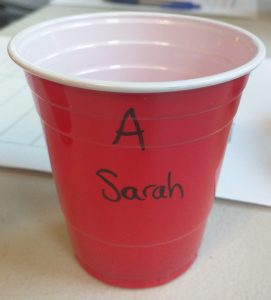
Before we started the tasting, we asked everyone to label their cups with their names, using a Sharpie. Unfortunately, Sharpie has a strong smell and for some people it overwhelmed the smell from the beer in the first couple of rounds. Next time, we will either ask people to write near the bottom of the cups rather than the mouth, or to write with pen on a label that can be stuck to the cups.
We poured the first round and the tasting began! Gerad explained techniques for smelling and tasting the beer. We kept each tasting round to five minutes. At the end of each round, there was discussion among everyone about which cup they thought was off, and what flavour they smelled. I then revealed which of their cups had been tainted, and with what compound. Gerad further explained what types of aromas the compound can cause, and what in the beer production process could cause this compound to be present. During his explanation, Tyler and I filled the spare sets of cups for the next round.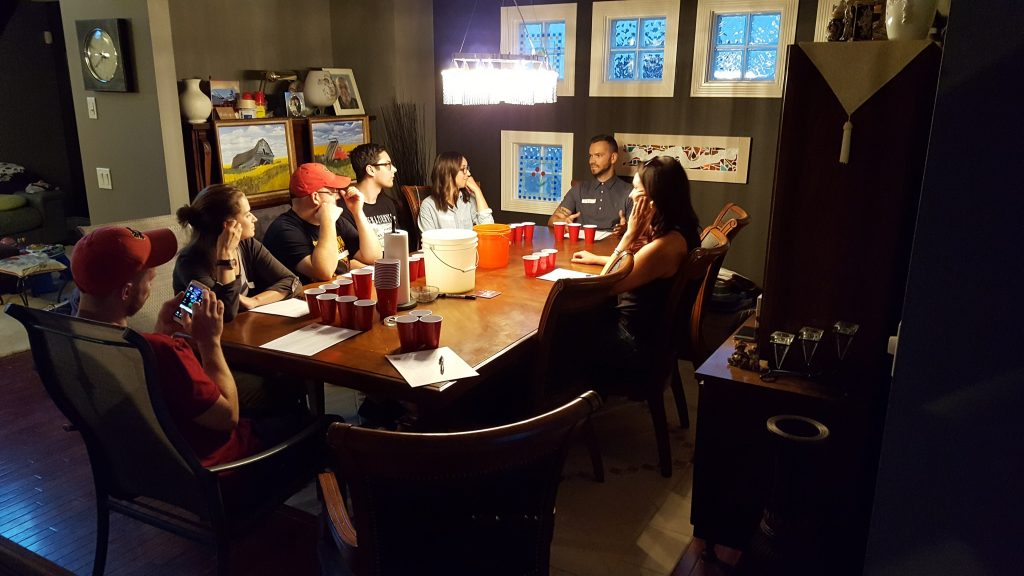
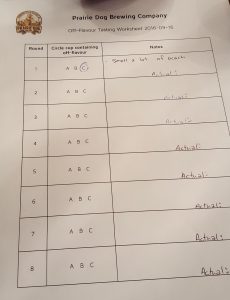 Off it went like that for the eight rounds. It was fun to learn about these off-flavours with a group of homebrewers and craft beer fans. We’ve heard about these flavours before, but being able to be exposed to them in a controlled way enabled us to be more confident about detecting these in the future, which will be particularly helpful for tasting our own beer – a good start for quality control!
Off it went like that for the eight rounds. It was fun to learn about these off-flavours with a group of homebrewers and craft beer fans. We’ve heard about these flavours before, but being able to be exposed to them in a controlled way enabled us to be more confident about detecting these in the future, which will be particularly helpful for tasting our own beer – a good start for quality control!
It was also interesting that for the most part, flavours were detected much more strongly by smell than by taste. Also, not everyone could detect each flavour, and further, some people detected off-flavours that were not offensive to them at all.
We did receive suggestions for how to improve the event in the future. Firstly, we can start by giving everyone a cup of the beer that we used for this event in a separate cup for participants to use as a reference either before, or throughout the tasting, because not everyone is familiar with the beer we chose. We could also start with a strong flavour that everyone should be able to detect, again so that they have a chance to get used to what the beer smells and tastes like without the off-flavour present and are able to learn what to look for to make the comparison. For this event, we only had one vial of each flavour, but eventually, we might be able to have enough of these on hand to add them to water, or just have them in their pure form, for people to smell without interference from the beer. We would let them smell the flavour for interest’s sake, after they’ve tried to smell it in beer.
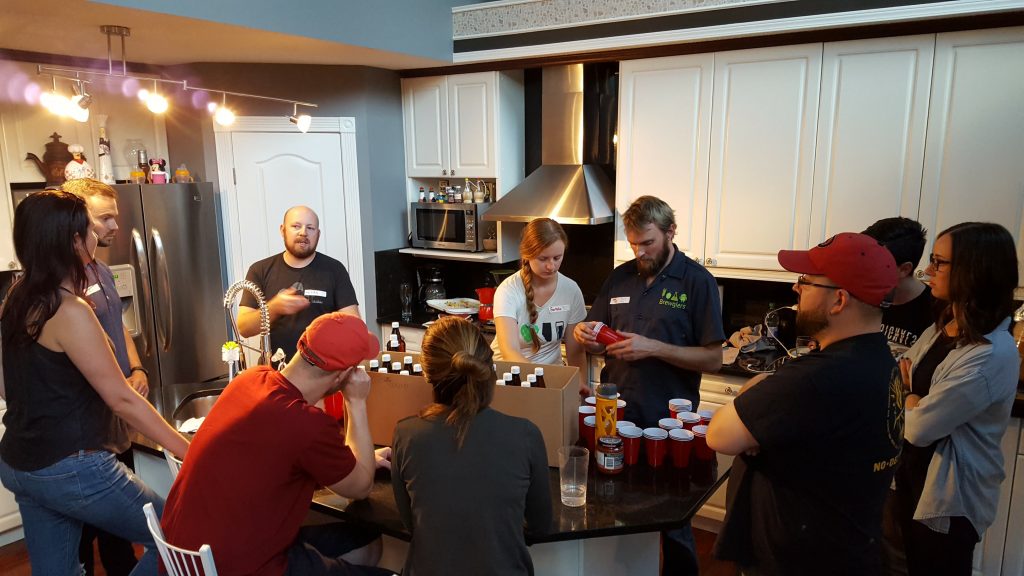 Overall, it was a successful event. We met some great people, both homebrewers and craft beer drinkers. We had fun tasting tainted beer, had fun drinking good beer afterwards, and it was generally a great time. We look forward to doing more of these types of events!
Overall, it was a successful event. We met some great people, both homebrewers and craft beer drinkers. We had fun tasting tainted beer, had fun drinking good beer afterwards, and it was generally a great time. We look forward to doing more of these types of events!
For the step-wise procedure, click here: Sensory Off-Flavour Tasting Event General Procedure
